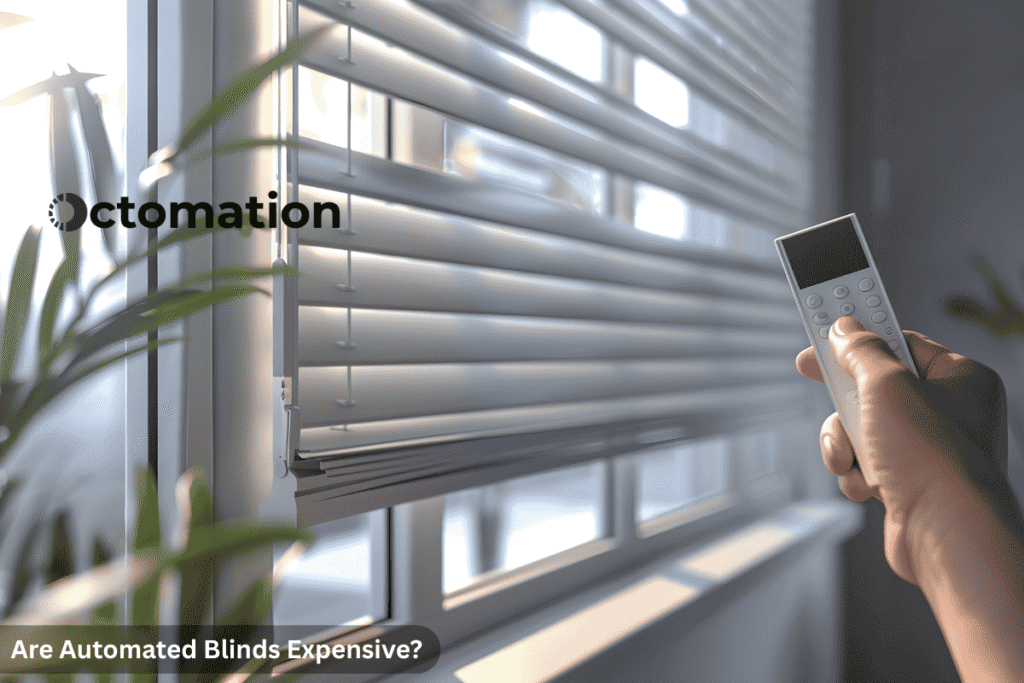Are Automated Blinds Expensive?

Automated blinds are becoming increasingly popular in today’s rapidly evolving smart home market, not just because of their stylish appearance but also because of the convenience and elegance they offer to homes and businesses. However, many people are hesitant because they believe motorized blinds are expensive. The secret is knowing what drives up the price and how these blinds provide long-term benefits that frequently exceed the original outlay.
Knowing the Definition of Automated Blinds
Automated blinds, also known as smart or motorized blinds, are window coverings that may be operated remotely through preset schedules, voice assistants like Google Home and Alexa, or smartphone apps. Rechargeable batteries, hardwired electric systems, or even solar energy can power these blinds. They are more than simply a contemporary convenience; they are a crucial component of intelligent interior design, which adapts to the time of day, the amount of light, or human preferences to create the ideal atmosphere within the house without requiring ongoing physical labor.
Analyzing Automated Blinds’ Prices
Several factors, including the type of material used, motor technology, level of smart integration, size, brand, and installation complexity, influence the cost of automated blinds. Premium, fully integrated smart blinds with voice and sensor-based automation can cost much more than entry-level motorized roller blinds, which can start at a few thousand rupees per window. There are additional installation expenses, particularly if smart home Company in Delhi integration or electrical wiring is needed.
The Impact of Design and Material on Cost
The blinds’ construction and appearance have a significant impact on the overall cost. Basic polyester or PVC blinds are less expensive, while wood, layered zebra cloth, blackout materials, and bespoke textures are more expensive. Furthermore, custom-made blinds for large or irregularly shaped windows are more costly than those in standard sizes. Both the overall cost and the elegance and aesthetic appeal of your interiors are increased by the more opulent and tailored material.

Budgetary Effects of Motor Technology and Power Options
The motor systems used by automated blinds can range from simple to sophisticated. Although battery-operated motors can be used to adapt old blinds and are generally more affordable, they may require battery changes every few years. Although hardwired solutions are more dependable and long-lasting, they also incur higher installation costs. Despite having a higher initial cost due to the additional panels and controllers required, solar-powered models are becoming increasingly popular because they are energy-efficient. The sophistication of the motor directly influences the quietness and smoothness of the blinds’ operation, and more advanced systems are inherently more expensive.
Integration of Smart Homes Increases Value — and Cost
Integration with Alexa, Google Home, or Apple HomeKit is a significant advantage for individuals seeking seamless control over their existing home automation company in gurgaon systems. However, such compatibility necessitates more intelligent sensors, controllers, and, occasionally, even specialized hubs. By enabling automation based on schedules, weather, daylight levels, or occupancy, this level of technology not only increases the initial cost but also enhances the user experience. This clever integration significantly increases the value of controlled blinds if you’re investing in a fully connected house.
Costs of Installation and Expert Setup
Another element where prices differ is installation. Installation is easy and can even be done by a do-it-yourselfer in basic battery-powered system installations. However, for hardwired systems or large-scale projects that require numerous rooms and smart hubs, professional installation is usually recommended. Wiring, configuration, calibration, and even app setup may incur fees. Professional installation ensures that your blinds function optimally from the start and integrate seamlessly with your larger smart ecosystem, although the additional service fees may seem costly.
Does Investing in Automated Blinds Make Sense in the Long Run?
Automated blinds can be a smart investment in the long run despite their somewhat high initial cost. For example, their capacity to adapt to sunlight lessens heat loss in the winter and gain in the summer, which eases the strain on heaters and air conditioners. Over time, this results in lower electricity expenses. Additionally, motorized blinds shield flooring and furniture from UV rays and enhance security by simulating occupancy while you’re away. Over time, they frequently result in significant savings due to their comfort, convenience, and energy efficiency.
Intelligent Automation Doesn’t Need to Cost Too Much
Not every motorized blind has a high price tag. Many domestic and international brands now offer reasonably priced models suitable for modest budgets. For homeowners who wish to experiment with smart living without a complete redecoration, retrofit kits that automate existing blinds are a useful option. Additionally, businesses such as Automation in India offer customized solutions, with packages made to meet both functional requirements and budgetary constraints. The cost per unit can be further decreased by group installations, seasonal sales, or combined packages that include home security and illumination.
Conclusion: Smart Convenience and Cost Balance
A significant advancement in creating a contemporary, effective, and refined atmosphere in any living space is the use of smart curtains. The long-term advantages, including energy savings, everyday convenience, increased security, and aesthetic enhancement, make the initial expenditure, even though it may be greater than with standard window coverings, truly worthwhile. The cost of motorized blinds should be viewed as an investment in the sustainability, style, and intelligence of your house rather than just an expense, whether you’re buying them for a smart apartment or a luxury villa.
Related Blogs
What Size Room for Home Cinema?